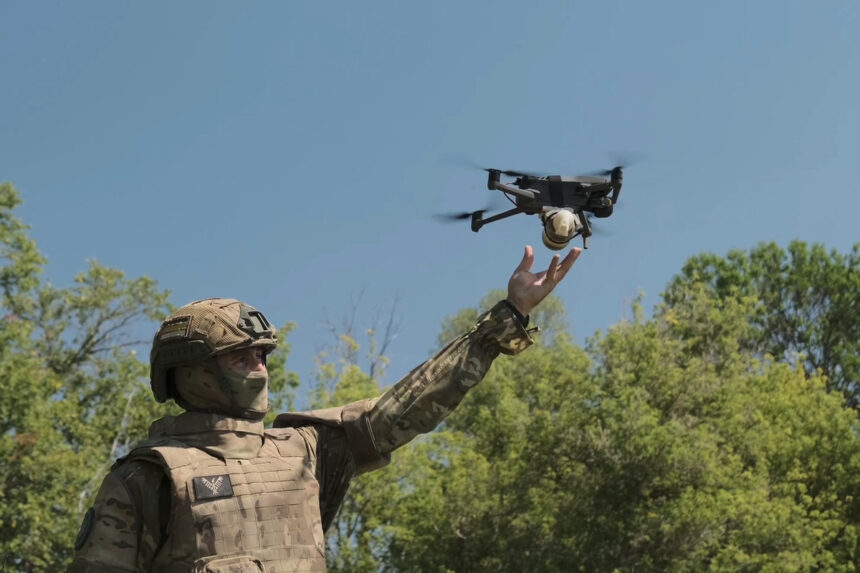Drone warfare, one of the defining features of more than two and a half years of full-scale war in Ukraine, is evolving rapidly. Hundreds of aerial drones zip in the sky above the front line every day, ticking off tasks ranging from reconnaissance to targeting, as well as kamikaze attacks designed to take out enemy armored vehicles, personnel and positions.
Among the most famous are the cheap first-person view (FPV) drones, now known for zooming in on battlefields and capturing footage regularly shared online by Russian and Ukrainian sources. Often, the video feed will cut off quickly as the drone approaches the target and explodes.
But although Ukraine’s stockpiles of various types of explosive drones are an important part of its unmanned aerial vehicle strategy, “we are short, very short of explosives,” Vadym Mazevych, former commander of the UAV battalion of the 3rd Separate Assault Brigade, told Newsweek during an interview in the capital of Ukraine on the sidelines of the Yalta European Strategy conference, organized by the Victor Pinchuk Foundation.
Some Ukrainian operators had turned on unexploded Russian shells and tried to retrieve the explosives, Mazevych said through an interpreter. It was a dangerous task, but “we need a communication system for these drones, and we need explosive materials.”

Press Service of the Ministry of Defense of Russia via AP
“We need a lot,” Mazevych added.
Also speaking in Kyiv was Serhii Varakin, commander of the drone unit in Ukraine’s 58th Brigade, who described this as “a problem that has been going on for a long time.”
Ukrainian forces have “cannibalized” unexploded ordinance for use against Russian forces, Varakin said. Newsweekalso through an interpreter.
“We have been short of explosives for a long time. It’s a big deficit, and we need a lot. We need them in large volumes,” Varakin later said in a written comment to Newsweek.
Ukraine’s drone operations on land, in the air and on water are massive. During the war, Kyiv said drone production was ramping up, and new designs were almost constantly debuting on social media. In late July, Kyiv defense officials said Ukraine could produce more than 3 million drones a year, with financial support from Ukraine’s international backers.
Ukrainian President Volodymyr Zelensky said in February that Kyiv would create a new branch of the Kyiv military, known as the Unmanned Systems Forces, specifically for drone warfare. “Drones, unmanned systems, have proven their effectiveness in combat on land, in the sky and at sea,” the Ukrainian leader said.
Earlier this week, Ukrainian Defense Minister Rustem Umerov said in an interview with Ukrainian media that Kyiv has developed a “very thorough and extensive” plan to lay out how Kyiv will produce drones, electronic warfare equipment and ground robots for the next three years.
The problem, Kiev officials stress, is funding. Ukraine’s capabilities far exceed the money channeled to more than 250 companies involved in drone production, said Oleksandr Kamyshin, Ukraine’s former minister of strategic industry, who oversees Kyiv’s defense industry.
“It’s very frustrating, it’s a shame, it works but we don’t have enough resources” for the defense industry, Kamyshin, now an adviser to the president on strategic affairs with a focus on the military-industrial complex, said. Newsweek.
Varakin said, “Ukraine can produce a lot of things, and we are more creative than Russia. What we need is the ability to produce space for this production and, of course, financing.”
“Funding will make it possible to develop various areas of concepts, not just areas of production,” added Mazevych.
Russia’s own industrial capacity is enormous. In December 2023, Samuel Bendett, a drone expert with CNA, a nonprofit for research and analysis based in Washington, told Newsweek that Russian volunteers, as well as state manufacturers and affiliates, have “significantly accelerated” the development of FPV drones and may be handing over tens of thousands of FPVs to the Russian military every month.
President Vladimir Putin said in mid-September that Russia is planning to increase the overall production of drones nearly tenfold in 2024. About 140,000 UAVs will be given to the Russian military in 2023, Putin said.
“The military industrial complex is expanding every day,” Mazevych said.
There is evidence that Russia launched up to 250 drones on a “very narrow” front, between 4.½ and 5 kilometers long, during the day,” he said.
“We might win in quality with drones, but Russia wins in quantity,” Varakin said.
“Back in the day, when we just released a homemade device with Mavic, they had already opened a factory and had already delivered factory-made drones,” he said, referring to the Mavic quadcopter manufactured by the Chinese technology company DJI.
Ukrainian companies may be pumping out drones, but many UAVs are seeing action from abroad. “We are very dependent on Chinese supplies,” Mazevych said.
As developers tweak drones, the tactics seen in Ukraine are also changing. Yegor Firsov, a staff sergeant with the Ukrainian military’s drone strike company, was only days away from the front lines in eastern Ukraine when he spoke to Newsweek in Kiev. But it’s been a long time since drone warfare tactics on the front lines have changed, he said.
When he saw the surveillance drone, Firsov said through an interpreter, “you might think I’m looking for, you know, armored vehicles, tanks, artillery pieces.”
Firsov’s 12-man unit, which spent the first part of September near the eastern cities of Pokrovsk and Toretsk, destroyed about 200 Russian military targets a month, he said.
When he’s looking for a target, Firsov said, chances are he’ll “see some enemy people using cars, bicycles, golf carts, maybe.—trying to move forward.” It was a “destroyed car, rebuilt for war purposes,” he said.
Varakin tells a similar story. “Recently, for example, Russia has stopped attacking with armor because when (a) Ukrainian FPV comes and attacks the armor, everyone inside will die.”
He continued: “So now they use cars, ATVs (all-terrain vehicles), motorcycles,” he said. “And if one FPV for 20 motorcyclists flies, it will only kill the motorcyclists.
“Russia is using a very different tactic and is getting better, constantly analyzing their mistakes and correcting them,” he said.




